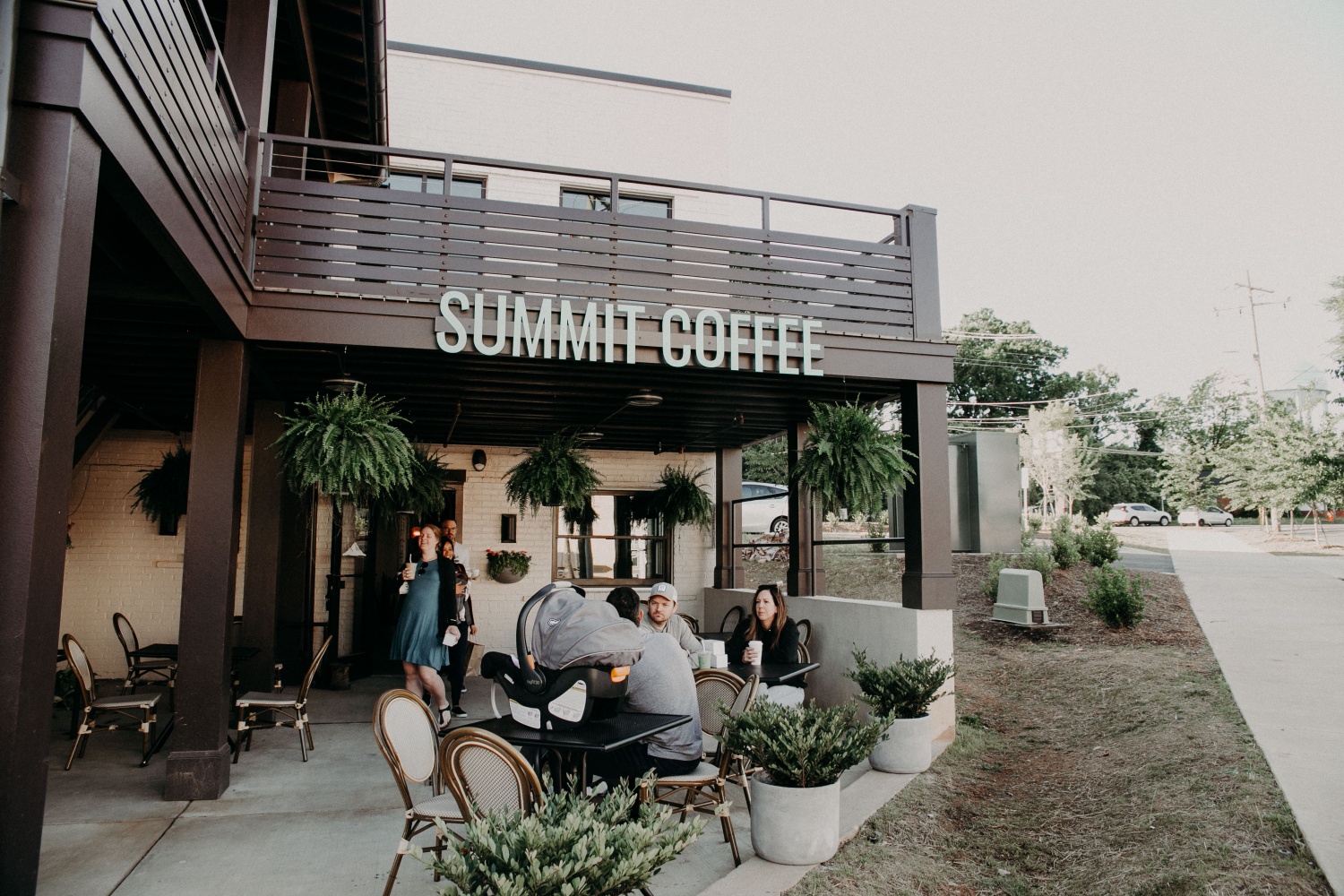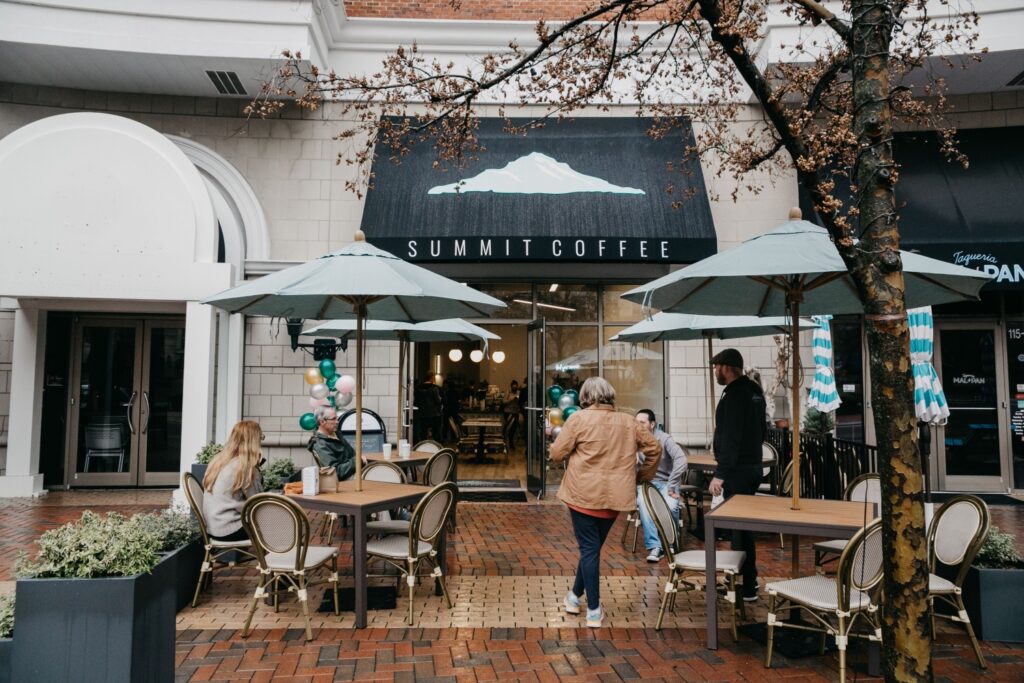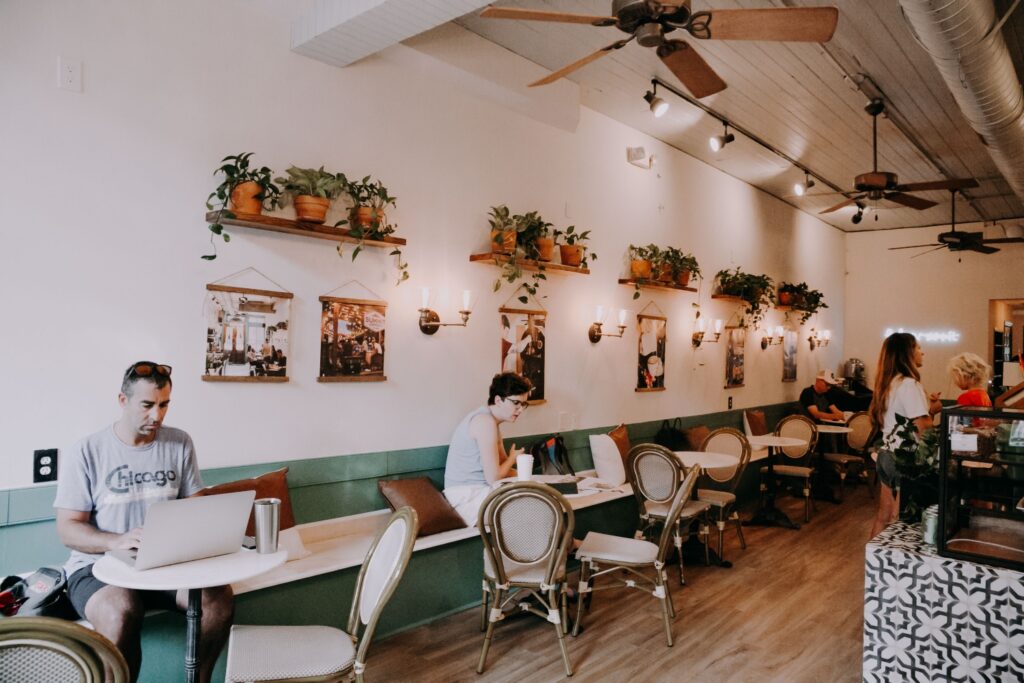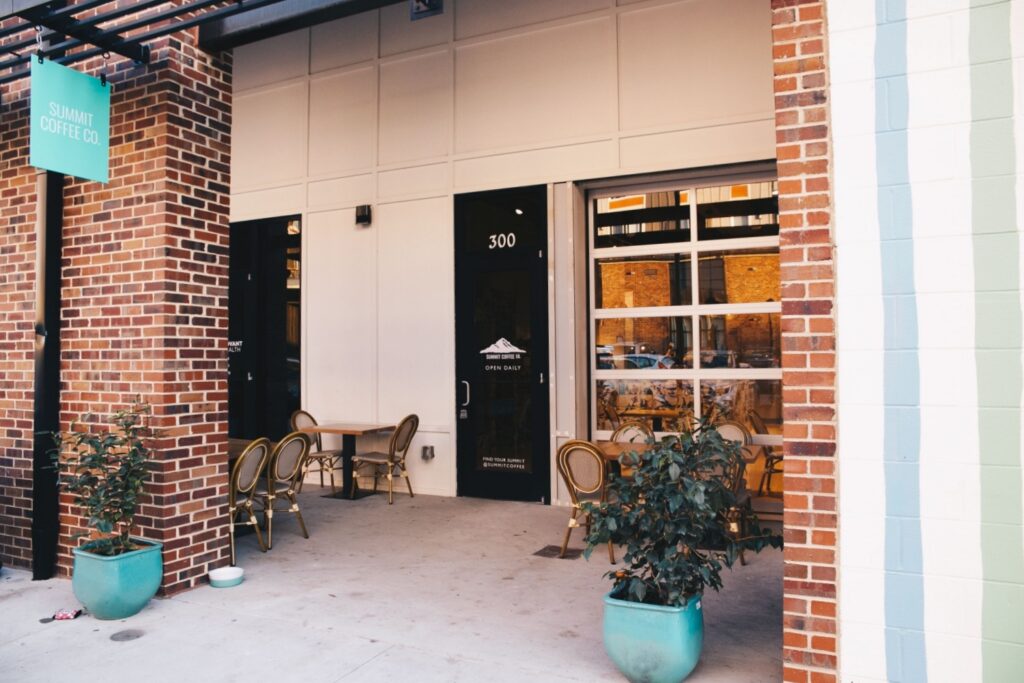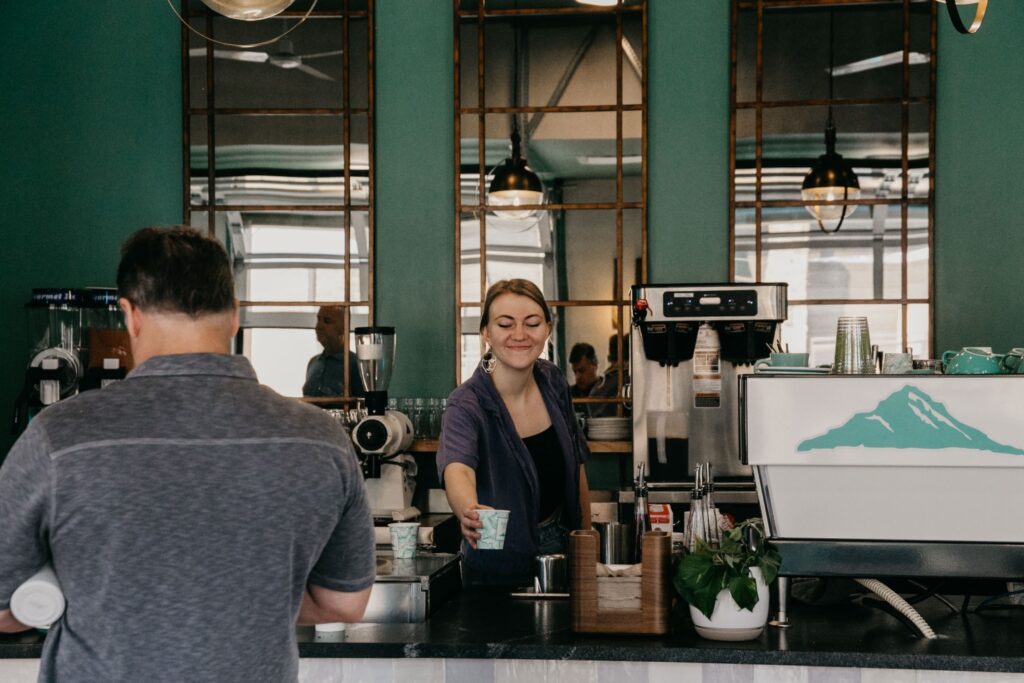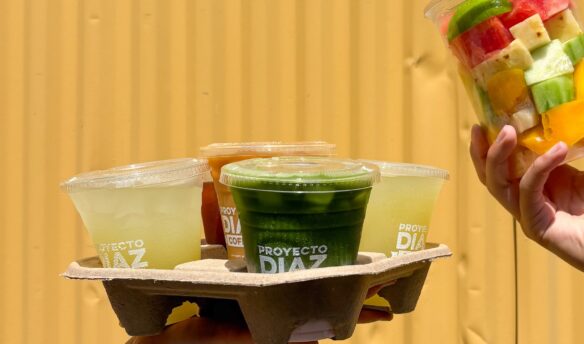[T]he specialty coffee space is dominated by independent coffee shops with one or two locations. Though many business owners may want to grow to more locations and expand their impact to new communities, expansion can feel out of reach. There are several hurdles to conquer:
- High buildout costs.
- The time it takes for each location to hit its operational stride.
- The widening proximity and disconnect between local staff and far-away owners.
And then there’s Summit Coffee: the coffee brand poised to open eight or more locations every year for the foreseeable future. Summit has found a creative solution in an industry where sustained growth can feel nearly impossible: franchising.
Within just two or three years, Summit could be one of the largest specialty coffee chains in the United States.
A Specialty Coffee Franchise 20 Years in the Making
Summit Coffee opened its doors in 1998 in Davidson, North Carolina. Like most coffee companies, they grew slowly and steadily, operating a second location and a roastery by 2015.
Nearly two decades into the venture, brothers Tim and Brian Helfrich were eager to try something new. Summit Coffee proved effective as a beloved local business, but the team knew there was more potential for the brand to grow.
Summit Coffee announced in late 2019 that the business would evolve into a franchise cafe model. Just over two years later, Summit Coffee launched its eighth location in Charlotte, North Carolina—and there are many more on the way.
We spoke with CEO and former Fresh Cup contributor Brian Helfrich to learn why and how Summit Coffee transitioned to the franchise model and how it’s enabling rapid growth.
Brian Gets Candid About Franchising
Our interview with Brian has been edited for clarity.
You say you’re the first specialty coffee franchise—what do you mean by that?
There are plenty of successful coffee franchises out there. Summit comes from a background of being a very third-wave coffee company. We’re an award-winning roaster, we do a lot of the relational coffee sourcing, and we follow the Counter Culture Coffee school of roasting (the roasting company we got our coffee from before we started roasting ourselves).
I felt like there was a big gap between third-wave coffee and franchise coffee in terms of how you can make a coffee concept that’s really terrific and still focused on quality but make it more ubiquitous in a way that a franchise can.
Why’d you go with the franchise model?
It became tough to explore what it’d be like to have five or ten cafes—to reconcile that we as owners wouldn’t be present locally for each location—that’s something we’re not willing to compromise on. We want to know our neighbors, know our neighborhood. We’d rather scale in a way that empowers people to run Summits in their neighborhoods rather than for me to be the CEO of a corporation where I only set foot in most cafes once a year. The franchise model just made sense for us.
There’s a stigma with franchising that the brand becomes overly corporatized and commoditized. We get that, so we’d like to position ourselves as “the anti-franchise franchise.” We definitely don’t do things the easy way that’s common in franchising. We have incredibly high standards for franchise partners; every cafe design is fully custom. For us, franchising enables that connectivity because owners are local.
I’m curious how you evaluated the economic risks and rewards of franchising.
We felt like the thing we did best was create a cafe experience, and we wanted to do it a lot more than we were. But opening a cafe takes a lot of money and time. And so, there’s a real ceiling on how quickly you can grow when you are self-funded and functionally a small startup business.
So we looked at our potential return on investment from opening three more Summits where we’re putting in, say, a quarter of a million dollars in each of those cafes. We didn’t have that kind of money. And certainly, if we did come up with that money once, getting that amount of money again—to be able to do that four and five more times—it would be difficult.
It was the confluence of what we want Summit to be, how we get there, and what’s financially reasonable. Franchising was a model that allowed us to empower other people who have financial resources to open one or two cafes, use our brand and skills and the systems we’ve built, and set somebody else up to run an extraordinary Summit location.
Do your customers notice or care that you’ve adopted this model?
Less than we thought when we first launched the franchise. Some people know it’s a franchise and a lot of people don’t. And I think that’s the right mix. We’re not trying to hide from it. But we’re also not trying to blow a trumpet at every grand opening talking about how we’re a franchise.
How did you find the time to dedicate to this transition?
I credit it primarily to having the right people on the team at the right time. Operationally, legally, branding—we just had such a smart, dynamic team ready for the challenge. We have a thirteen-person Summit leadership team that oversees the whole operation, and eleven of those people started at Summit as baristas.
We have this culture of curiosity and hire optimistic and intelligent people, and we’re generally really good at learning as we need to learn.
So if I want to open a Summit Coffee location, what do I have to bring to the table?
The franchisee pays for everything, and they bring the funding. But what they need to bring is a commitment to being a great cafe operator. That means hands-on, active time at the cafe, a shared set of values on being a good employer, and a willingness to create something that impacts the local community.
What does Summit HQ provide franchisees?
We give franchisees everything they need to succeed from an operational perspective. We have proven systems, and we have the experiences and skills that will help them skip past the phase of making all the mistakes a small business does.
We bring over eighty hours of training, software, brand marketing, menu management, and scheduling systems. We support them in hiring staff and a manager. We even have guidelines for giving managers bonuses based on specific metrics and are available to help them achieve those, so they also have some upside and stick around.
Who’s in charge of marketing?
We have an internal marketing team that runs our brand strategy, online ordering experience, and helps local owners understand how local marketing works. So we show them how to run their location’s social media, run ads, and empower them to turn their cafe into a storytelling enterprise. Then they take it from there, so it’s truly local and authentic.
How do you maintain consistency across all the locations?
We’ve become increasingly prescriptive of our coffee program. Even if the cafe experience is different, we want customers to go to other Summits and trust that they are getting an awesome latte or that the single-origin coffee they get will be dialed in. That became really important to us, so Summit HQ acts as the primary supply chain and supplier for all things served from the coffee and drink menu.
We’d get wildly different cups if we left it up to all of our different cafes to dial in the batch brew. And so that’s why we have a coffee quality coordinator who visits every cafe personally. They work with the managers and the franchise owners to dial in that coffee, so they are empowered to know what the optimal cup tastes like, rather than just shipping them coffee beans and saying good luck.
As we get away from the core goods, whether it’s food or beer or wine, we let owners engage a little more locally to find those things.
What do other business owners need to know about growing beyond 1-2 locations?
There are two things I would say.
One, relentlessly pursue what you know you’re best at. For us, putting together a customer experience in the cafe is the best thing we do: the smells, the sounds, the decor, the way equipment is positioned on the counter, and what it feels like to be served by a barista. For others, that might be barista culture or pure dedication to quality. You have to pick your focus and do it very well.
Two, you need to know your numbers inside out. In all my years running Summit, one of the things I’m most proud of is that we didn’t have to let go of a single employee through COVID. That’s because we looked at every penny spent, set targets, and made sure we got as close as possible. We eliminated some things we were doing, created better systems, and hit our goals. You have to know exactly what you’re spending money on.
What’s next for Summit Coffee?
Specifically for growth, we’re going to open eight to ten locations per year.
One of the big things we haven’t talked much about is that we want to become a leader in sustainability. That’s probably the biggest challenge we’ll face in the world over the next few decades, so we’re doing a lot to think critically about how we can do better.
We just became a Climate Neutral roastery in early 2022. We’re testing out a zero-waste cafe concept at one of our stores. We’re in the process of applying for the B Corp certification. And I think this is really important to us not just as a business strategy but to be responsible people in the world.
Follow Summit Coffee and Brian Helfrich to keep up with the brand.
Garrett Oden is the owner of Fresh Cup, a coffee industry publication for professionals, and Garrett Oden Copywriting, a content and copywriting agency for coffee, F&B, and food tech businesses.



